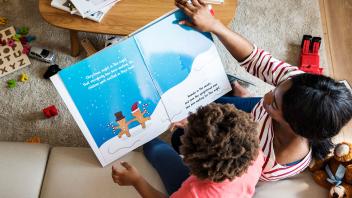Infants and toddlers
Helping your child love books
You’ll find sharing books together is a great way to bond with your son or daughter. Reading also helps your child’s language development and listening skills when you talk about the story and ask questions. Don’t forget that sitting side-by-side listening to audio books together is another way to introduce stories to your child with vision challenges.
Large print books can help a child with mild to moderate vision loss discover the world of books. These books have big print and offer high contrast between the words and the page to make tracking the words easier. Visit your library and ask for the large print book section.
Children who have little or no sight may learn to read Braille. Braille books have raised “letters.” Children in elementary school can get free Braille books up to 12 times a year. Call the American Action Fund for Blind Children and Adults at (410) 659-9315 ext. 2287 to learn more. Give your child a great gift that will last for life — the love of books.
Tips for reading with your infant or toddler
Each time you read to your baby, you are helping your child’s brain to develop. Reading aloud to your child allows him to hear your voice and listen to spoken words. Your child is also more likely to ask questions and learn about the world around him. So — you’ve planted the seed to reading that will stay with your child throughout his life.
Since younger children have short attention spans, try reading for a few minutes at a time at first. Then build up the time you read together. Your child will soon see reading time as both fun time and learning time!
Here are some things you can try:
- Sit your child next to you. If your child has low vision, make sure there is plenty of light to help him see the page.
- Buy books or borrow books from the library that have textures your child can touch.
- Help your toddler feel pop-up or raised objects you name in the book.
- Read aloud. Talk about the pictures and read the text.
- Find books that have rhymes. Clap your hands and help your baby clap along to the rhythm.
- Find books that have buttons your child can press that have sounds.
Suggested books for your infant
Look for books that have soft or textured shapes. Find books that have pop-out pieces and textures your child can feel and name. Some titles include:
- Pat the Bunny , and other Touch and Feel books by Dorothy Kunhardt
- Three Little Duckies , and other Float Along Books with toys to handle
- Where Is Baby’s Belly Button? , by Karen Katz
Suggested books for your toddler
- Are You Ticklish? , by Melanie Mitchell
- Whose Back is Bumpy? or High Tide , by Kate Davis
Preschool and school-age children
Helping your preschooler or school-age child love books
Remember, when you read to your child often and combine reading time with cuddle and play time, your child will link books with fun times together.
Here are some things you can try:
- Sit your child next to you. If your child has low vision, make sure there is plenty of light to help your child see the page.
- Read aloud. Talk about the pictures and read the text.
- Find large print books on topics that interest your child, such as books on animals or sports.
- Find books that have buttons to press that make sounds. Buy audio books that your child can start or stop by pressing a button.
- Find Braille books if your child reads Braille.
- Praise your child’s efforts at reading!
Suggested books for your preschooler or school-age child
- The Wheels on the Bus Go Round and Round , and other books with wheels that move
- A Children’s Treasury of Nursery Rhymes , and other children’s poetry books
- Mr. Brown Can Moo! Can You? (use with plastic or stuffed animals)
Books to help children and parents learn more about vision loss
For children
- Anna & Natalie , by Barbara H. Cole (Ages 7–12)
- Saltypie: A Choctaw Journey from Darkness into Light , by Tim Tingle (Ages 5–10)
- Follow My Leader , by James Garfield (Ages 8–12)
For parents
- Braille for the Sighted: Beginning Braille , by S. Harold Collins, Jane Schneider, and Kathy Kifer
- Children with Visual Impairments: A Guide for Parents , edited by M. Cay Holbrook
- Experiencing Literacy: A Parents’ Guide for Fostering Literacy Development of Children with Visual Impairment , by Alan Koenig and M. Cay Holbrook
- Look at It This Way: Toys and Activities for Children with Visual Impairment , by Roma Lear
For more information
- American Action Fund for Blind Children and Adults — (410) 659-9315
- American Foundation for the Blind — (800) 232-3044
- Centers for Disease Control and Prevention — (800) CDC-INFO
- National Association for Parents of Children with Visual Impairments — (800) 562-6265
- National Dissemination Center for Children with Disabilities —
(800) 695-0285 - National Eye Institute/National Institutes of Health
Developmental Disabilities Literacy Promotion Guide for Pediatric Healthcare Providers. ©2010 Reach Out and Read, Inc. All rights reserved. Reprinted with permission.


